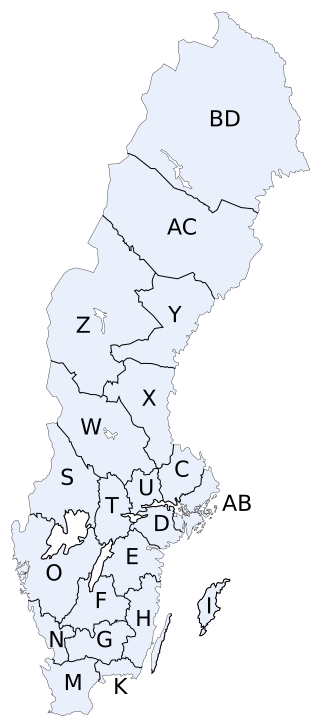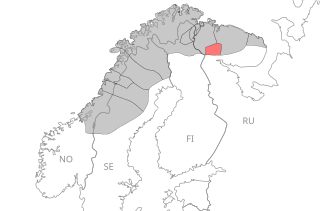An abbreviation is a shortened form of a word or phrase, by any method including shortening, contraction, initialism or crasis.

In grammar, the genitive case is the grammatical case that marks a word, usually a noun, as modifying another word, also usually a noun—thus indicating an attributive relationship of one noun to the other noun. A genitive can also serve purposes indicating other relationships. For example, some verbs may feature arguments in the genitive case; and the genitive case may also have adverbial uses.

The mile, sometimes the international mile or statute mile to distinguish it from other miles, is a British imperial unit and United States customary unit of length; both are based on the older English unit of length equal to 5,280 English feet, or 1,760 yards. The statute mile was standardised between the Commonwealth of Nations and the United States by an international agreement in 1959, when it was formally redefined with respect to SI units as exactly 1,609.344 metres.
In linguistics, grammatical person is the grammatical distinction between deictic references to participant(s) in an event; typically, the distinction is between the speaker, the addressee, and others. A language's set of pronouns is typically defined by grammatical person. First person includes the speaker, second person is the person or people spoken to, and third person includes all that are not listed above. It also frequently affects verbs, and sometimes nouns or possessive relationships.
The Finnish language is spoken by the majority of the population in Finland and by ethnic Finns elsewhere. Unlike the Indo-European languages spoken in neighbouring countries, such as Swedish and Norwegian, which are North Germanic languages, or Russian, which is a Slavic language, Finnish is a Uralic language of the Finnic languages group. Typologically, Finnish is agglutinative. As in some other Uralic languages, Finnish has vowel harmony, and like other Finnic languages, it has consonant gradation.
The T–V distinction is the contextual use of different pronouns that exists in some languages and serves to convey formality or familiarity. Its name comes from the Latin pronouns tu and vos. The distinction takes a number of forms and indicates varying levels of politeness, familiarity, courtesy, age or even insult toward the addressee. The field that studies and describes this phenomenon is sociolinguistics.
Dual is a grammatical number that some languages use in addition to singular and plural. When a noun or pronoun appears in dual form, it is interpreted as referring to precisely two of the entities identified by the noun or pronoun acting as a single unit or in unison. Verbs can also have dual agreement forms in these languages.

Län, lääni and len refer to the administrative divisions used in Sweden and previously in Finland and Norway. The provinces of Finland were abolished on January 1, 2010. In Norway, the term was in use between 1308 and 1662.

The word thou is a second-person singular pronoun in English. It is now largely archaic, having been replaced in most contexts by the word you, although it remains in use in parts of Northern England and in Scots. Thou is the nominative form; the oblique/objective form is thee ; the possessive is thy (adjective) or thine ; and the reflexive is thyself. When thou is the grammatical subject of a finite verb in the indicative mood, the verb form typically ends in -(e)st, but in some cases just -t.

A plurale tantum is a noun that appears only in the plural form and does not have a singular variant for referring to a single object. In a less strict usage of the term, it can also refer to nouns whose singular form is rarely used.
Several linguistic issues have arisen in relation to the spelling of the words euro and cent in the many languages of the member states of the European Union, as well as in relation to grammar and the formation of plurals.

Historical Russian units of measurement were standardized and used in the Russian Empire and after the Russian Revolution, but were abandoned after 21 July 1925, when the Soviet Union adopted the metric system.
A league is a unit of length. It was common in Europe and Latin America, but is no longer an official unit in any nation. Derived from an ancient Celtic unit and adopted by the Romans as the leuga, the league became a common unit of measurement throughout western Europe. Since the Middle Ages, many values have been specified in several countries.
Traditional Tatar units of measurement were used by Tatars until 1924 but became obsolete when the Soviet Union adopted the metric system.

Akkala Sámi, also referred to, particularly in Russia, as Babin Sámi, was a Sámi language spoken in the Sámi villages of Aʼkkel, Čuʼkksuâl and Sââʼrvesjäuʼrr, in the inland parts of the Kola Peninsula in Russia. Formerly erroneously regarded as a dialect of Kildin Sámi, it has recently become recognized as an independent Sámi language that is most closely related to its western neighbor Skolt Sámi, and the two are somewhat mutually intelligible.
The obsolete Finnish units of measurement consist mostly of a variety of units traditionally used in Finland that are similar to those that were traditionally used in other countries and are still used in the United Kingdom and the United States.

A Scandinavian mile is a unit of length common in Norway and Sweden, to a lesser extent in Finland, but not Denmark. Today, it is standardised as 1 mil being 10 kilometres, but it had different values in the past.

Finnish is a Finnic language of the Uralic language family, spoken by the majority of the population in Finland and by ethnic Finns outside of Finland. Finnish is one of the two official languages of Finland, alongside Swedish. In Sweden, both Finnish and Meänkieli are official minority languages. Kven, which like Meänkieli is mutually intelligible with Finnish, is spoken in the Norwegian counties of Troms and Finnmark by a minority of Finnish descent.

In linguistic morphology, inflection is a process of word formation in which a word is modified to express different grammatical categories such as tense, case, voice, aspect, person, number, gender, mood, animacy, and definiteness. The inflection of verbs is called conjugation, while the inflection of nouns, adjectives, adverbs, etc. can be called declension.










